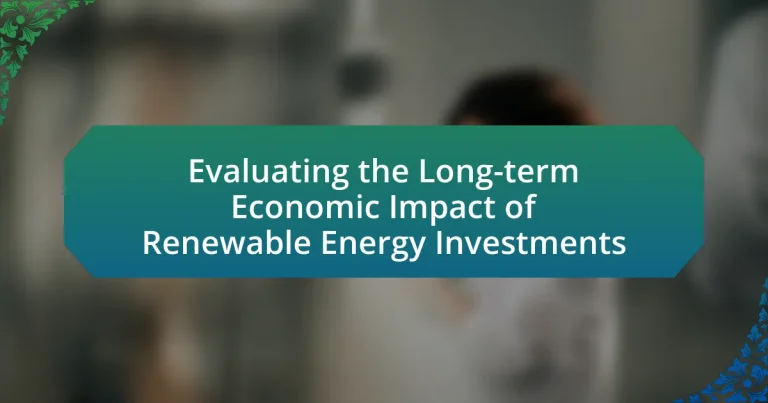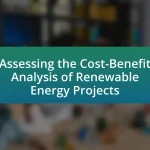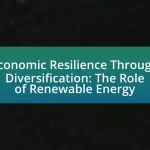The article evaluates the long-term economic impact of renewable energy investments, highlighting their significance in job creation, energy cost savings, and enhanced energy security. It discusses how transitioning to renewable sources can lead to millions of jobs, with the renewable energy sector employing over 11 million people globally as of 2018. The article also examines the influence of renewable energy investments on economic growth, key indicators of this growth, and the potential risks associated with such investments. Additionally, it compares different types of renewable energy investments, focusing on solar and wind energy, and outlines the factors that affect their economic viability, including government policies, technological advancements, and market demand.
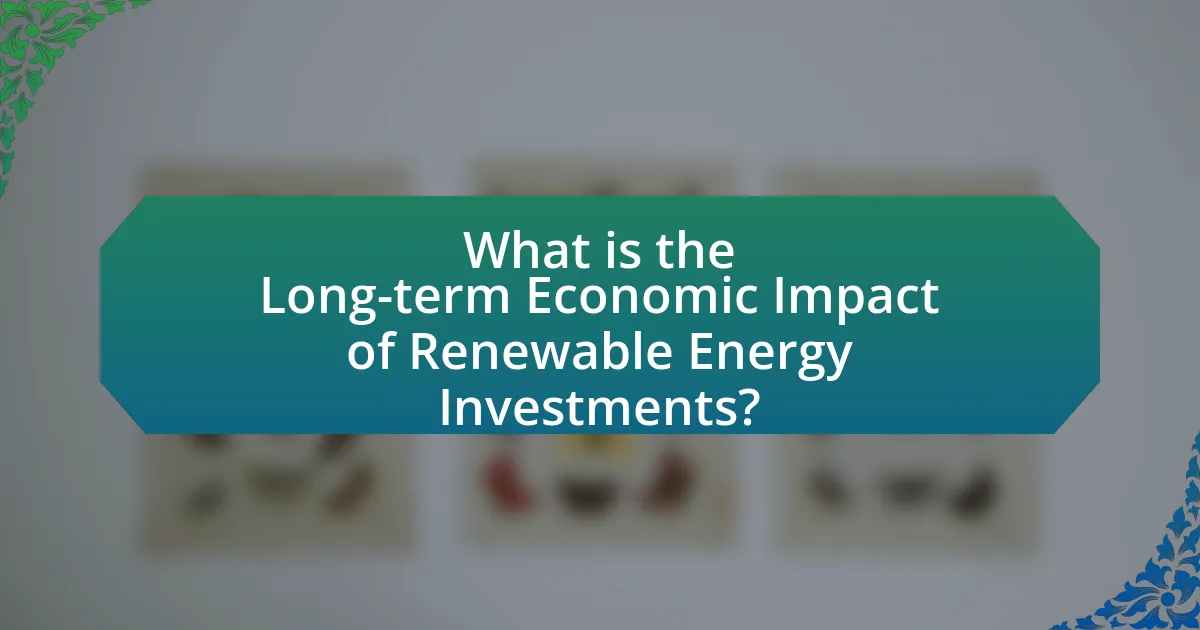
What is the Long-term Economic Impact of Renewable Energy Investments?
The long-term economic impact of renewable energy investments is significant, leading to job creation, energy cost savings, and enhanced energy security. Studies indicate that transitioning to renewable energy sources can create millions of jobs; for instance, the International Renewable Energy Agency reported that the renewable energy sector employed over 11 million people globally in 2018, with projections for continued growth. Additionally, renewable energy investments reduce reliance on fossil fuels, leading to lower energy costs over time. According to a report by Lazard, the cost of solar and wind energy has decreased by 88% and 69% respectively since 2009, making them increasingly competitive with traditional energy sources. Furthermore, investing in renewables enhances energy security by diversifying energy sources and reducing vulnerability to price volatility in fossil fuel markets. Overall, these factors contribute to a more resilient and sustainable economy.
How do renewable energy investments influence economic growth?
Renewable energy investments significantly influence economic growth by creating jobs, stimulating technological innovation, and reducing energy costs. For instance, the International Renewable Energy Agency reported that the renewable energy sector employed over 11 million people globally in 2018, demonstrating job creation as a direct result of these investments. Additionally, investments in renewable technologies lead to advancements that enhance efficiency and lower production costs, further contributing to economic expansion. A study by the U.S. Department of Energy found that every $1 million invested in renewable energy generates approximately 7.49 jobs, highlighting the sector’s role in job creation and economic stimulation. Furthermore, as renewable energy sources become more prevalent, they contribute to lower energy prices, which can boost disposable income and consumer spending, ultimately fostering economic growth.
What are the key indicators of economic growth related to renewable energy?
Key indicators of economic growth related to renewable energy include job creation, investment levels, and energy production capacity. Job creation in the renewable energy sector has been significant; for instance, the International Renewable Energy Agency reported that the sector employed over 11 million people globally in 2018, with continued growth expected. Investment levels are also a critical indicator; global investments in renewable energy reached approximately $282 billion in 2019, reflecting increasing confidence in the sector’s potential for economic growth. Additionally, energy production capacity, measured in gigawatts, serves as a vital indicator; as of 2020, global renewable energy capacity surpassed 2,800 gigawatts, demonstrating the sector’s expanding role in meeting energy demands and contributing to economic development.
How do job creation and employment rates factor into this impact?
Job creation and employment rates significantly influence the long-term economic impact of renewable energy investments by driving economic growth and enhancing community stability. Increased job creation in the renewable energy sector leads to higher employment rates, which in turn boosts consumer spending and stimulates local economies. For instance, a report by the International Renewable Energy Agency (IRENA) indicated that the renewable energy sector employed over 11 million people globally in 2018, with projections suggesting this number could rise to 24 million by 2030, demonstrating the sector’s potential for job creation. This growth in employment not only reduces unemployment rates but also contributes to a more skilled workforce, fostering innovation and further investment in renewable technologies.
What are the potential risks associated with renewable energy investments?
The potential risks associated with renewable energy investments include regulatory changes, technological obsolescence, and market volatility. Regulatory changes can impact the profitability of projects; for instance, shifts in government policies or incentives can alter financial projections significantly. Technological obsolescence poses a risk as advancements may render existing technologies less competitive or outdated, affecting investment returns. Market volatility, influenced by fluctuating energy prices and demand, can lead to unpredictable revenue streams, making it challenging for investors to forecast long-term profitability. According to a report by the International Renewable Energy Agency, these factors can significantly affect the financial viability of renewable energy projects, highlighting the importance of thorough risk assessment in investment decisions.
How do market fluctuations affect the stability of renewable energy investments?
Market fluctuations significantly impact the stability of renewable energy investments by influencing capital costs, project financing, and investor confidence. For instance, volatility in energy prices can lead to uncertainty in revenue projections, making it challenging for investors to assess the long-term viability of renewable projects. According to a report by the International Renewable Energy Agency (IRENA), fluctuations in fossil fuel prices can affect the competitiveness of renewable energy sources, as seen during periods of low oil prices when investment in renewables tends to decline. Additionally, changes in government policies and market incentives, often driven by economic conditions, can further destabilize investment in the renewable sector. This interplay between market dynamics and renewable energy investment highlights the need for stable policy frameworks to mitigate risks associated with market fluctuations.
What are the environmental risks tied to renewable energy projects?
Renewable energy projects pose several environmental risks, including habitat destruction, resource depletion, and pollution. For instance, the construction of wind farms can disrupt local ecosystems and bird migration patterns, while solar farms may require significant land use, impacting wildlife habitats. Additionally, the production of renewable energy technologies, such as solar panels and batteries, involves mining for rare minerals, which can lead to soil and water contamination. A study by the National Renewable Energy Laboratory highlights that while renewable energy reduces greenhouse gas emissions, it can still have localized environmental impacts that must be managed effectively.
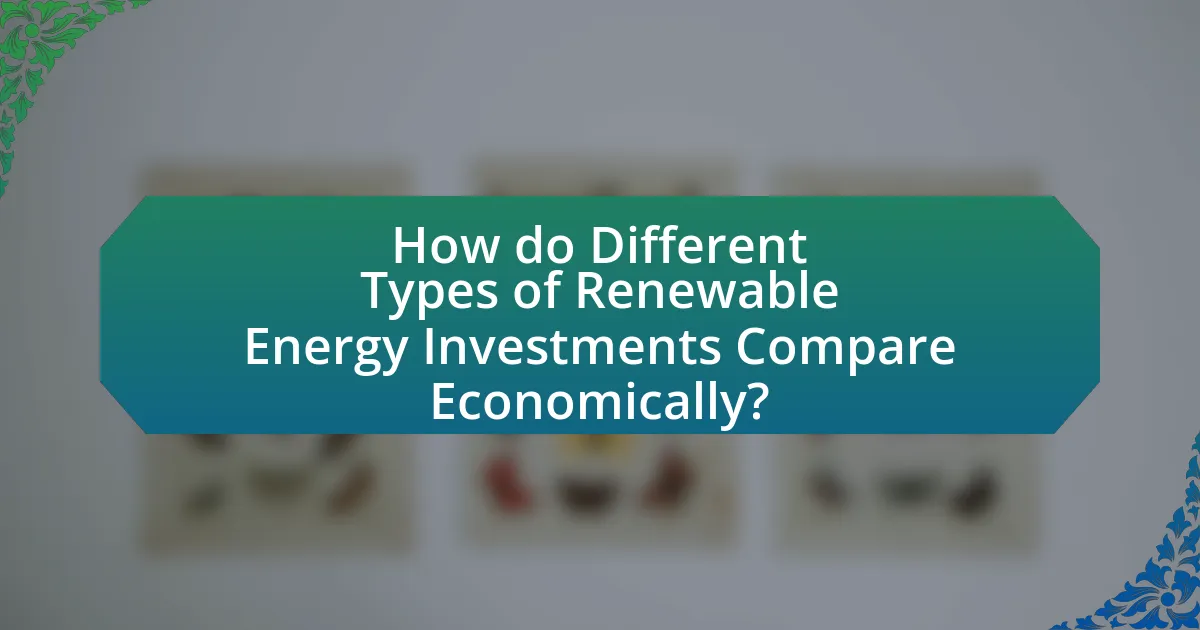
How do Different Types of Renewable Energy Investments Compare Economically?
Different types of renewable energy investments compare economically based on their initial costs, operational expenses, and return on investment (ROI). For instance, solar energy investments typically require higher upfront costs for installation but have lower operational costs and can yield significant savings on electricity bills over time. Wind energy investments, while also having substantial initial costs, often benefit from economies of scale and can generate higher returns in areas with consistent wind patterns. According to the International Renewable Energy Agency (IRENA), the levelized cost of electricity (LCOE) for solar has decreased by 89% since 2010, making it one of the most cost-effective energy sources. In contrast, hydropower investments generally have high initial costs but provide stable and long-term returns due to their ability to generate consistent energy. Overall, the economic comparison of renewable energy investments varies significantly based on technology, location, and market conditions, with solar and wind often leading in cost-effectiveness in many regions.
What are the economic impacts of solar energy investments?
Solar energy investments have significant economic impacts, including job creation, reduced energy costs, and increased energy independence. Specifically, the solar industry has generated over 250,000 jobs in the United States as of 2021, according to the Solar Foundation’s National Solar Jobs Census. Additionally, solar energy can lower electricity bills for consumers and businesses, with the U.S. Department of Energy reporting that solar installations can save homeowners an average of $20,000 over 20 years. Furthermore, investments in solar energy contribute to energy independence by reducing reliance on fossil fuels, which can stabilize local economies and enhance energy security.
How does solar energy investment affect local economies?
Solar energy investment positively affects local economies by creating jobs, increasing local tax revenues, and stimulating economic growth. For instance, a study by the National Renewable Energy Laboratory found that every megawatt of solar power installed creates approximately 5.65 jobs, contributing to local employment rates. Additionally, solar projects often lead to increased property tax revenues, which can be reinvested into community services. In California, solar energy investments have generated over $1 billion in local tax revenues, enhancing public infrastructure and services. Furthermore, the presence of solar facilities can attract related businesses, fostering a more robust local economy.
What are the long-term financial returns of solar energy projects?
The long-term financial returns of solar energy projects typically range from 10% to 30% internal rate of return (IRR) over a 20 to 30-year lifespan. These returns are driven by factors such as reduced energy costs, government incentives, and the increasing value of renewable energy. For instance, a study by the National Renewable Energy Laboratory found that utility-scale solar projects can achieve an average levelized cost of electricity (LCOE) of $30 to $60 per megawatt-hour, making them competitive with fossil fuels. Additionally, the Solar Energy Industries Association reported that the solar industry has seen a consistent decline in costs, with prices dropping by over 80% since 2010, further enhancing financial returns.
What are the economic implications of wind energy investments?
Wind energy investments have significant economic implications, including job creation, reduced energy costs, and increased energy independence. The U.S. wind sector employed over 116,000 workers in 2020, with projections indicating that this number could grow as investments increase. Additionally, wind energy has been shown to lower electricity prices; for instance, the levelized cost of energy from onshore wind dropped by 70% from 2009 to 2019, making it one of the most cost-effective energy sources. Furthermore, wind energy contributes to energy independence by reducing reliance on fossil fuels, which can stabilize local economies and enhance energy security. These factors collectively underscore the positive economic impact of wind energy investments.
How does wind energy investment contribute to energy independence?
Wind energy investment significantly contributes to energy independence by reducing reliance on imported fossil fuels. By developing domestic wind energy resources, countries can generate their own electricity, which decreases vulnerability to global energy market fluctuations and geopolitical tensions. For instance, in the United States, the wind energy sector has grown to provide over 8% of the nation’s electricity, which translates to a reduction of approximately 329 million barrels of oil annually, according to the U.S. Department of Energy. This shift not only enhances energy security but also fosters local job creation and economic growth, reinforcing the overall benefits of investing in wind energy.
What are the cost-benefit analyses of wind energy projects?
Cost-benefit analyses of wind energy projects typically reveal that the benefits, including reduced greenhouse gas emissions, energy independence, and job creation, often outweigh the costs associated with installation and maintenance. For instance, a study by the National Renewable Energy Laboratory found that the levelized cost of energy (LCOE) for onshore wind has decreased by 70% since 2009, making it one of the most cost-effective energy sources. Additionally, the U.S. Department of Energy reported that wind energy projects can create approximately 1.5 jobs per megawatt installed, contributing significantly to local economies. These analyses demonstrate that investing in wind energy not only provides environmental benefits but also fosters economic growth and stability.
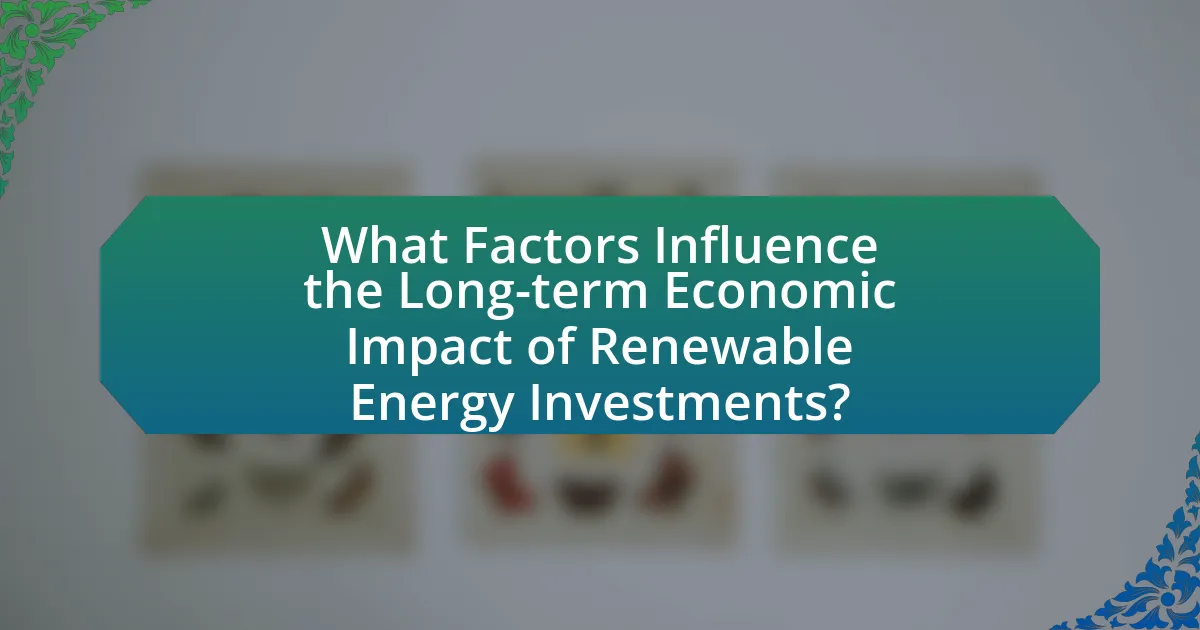
What Factors Influence the Long-term Economic Impact of Renewable Energy Investments?
The long-term economic impact of renewable energy investments is influenced by factors such as technological advancements, government policies, market demand, and the cost of traditional energy sources. Technological advancements lead to increased efficiency and reduced costs in renewable energy production, making it more competitive. Government policies, including subsidies and tax incentives, can significantly enhance investment attractiveness and drive market growth. Market demand for clean energy is rising due to environmental concerns and consumer preferences, further supporting economic viability. Additionally, fluctuations in the cost of fossil fuels can affect the competitiveness of renewable energy, as lower fossil fuel prices may deter investment in renewables. These factors collectively shape the economic landscape for renewable energy investments over the long term.
How do government policies affect renewable energy investments?
Government policies significantly influence renewable energy investments by providing financial incentives, regulatory frameworks, and market stability. For instance, subsidies and tax credits, such as the Investment Tax Credit (ITC) in the United States, have been shown to increase solar energy investments by making projects more financially viable. According to the Solar Energy Industries Association, the ITC has contributed to a more than 10-fold increase in solar capacity since its implementation. Additionally, renewable energy mandates and clean energy standards create a predictable market environment that encourages long-term investments. Research from the International Renewable Energy Agency indicates that countries with supportive policies see higher levels of investment in renewable technologies, leading to accelerated growth in the sector.
What incentives are available for renewable energy investors?
Renewable energy investors can access various incentives, including tax credits, grants, and rebates. For instance, the Investment Tax Credit (ITC) allows investors to deduct a significant percentage of the cost of solar energy systems from their federal taxes, which was 26% for systems installed in 2020 and 2021, and is set to decrease in subsequent years. Additionally, the Production Tax Credit (PTC) provides a per-kilowatt-hour tax credit for electricity generated by qualified renewable energy resources, such as wind and geothermal. State-level incentives also exist, such as Renewable Portfolio Standards (RPS) that require utilities to obtain a certain percentage of their energy from renewable sources, often accompanied by financial incentives for compliance. These incentives are designed to stimulate investment in renewable energy, thereby promoting economic growth and sustainability.
How do regulations shape the economic landscape for renewable energy?
Regulations significantly shape the economic landscape for renewable energy by establishing frameworks that incentivize investment and development. These regulations, such as tax credits, renewable portfolio standards, and feed-in tariffs, create a stable environment that encourages businesses to invest in renewable technologies. For instance, the Investment Tax Credit (ITC) in the United States has led to a substantial increase in solar energy installations, contributing to a 167% growth in solar capacity from 2016 to 2020. Furthermore, regulations can also impose penalties on carbon emissions, driving companies to transition to cleaner energy sources, thereby influencing market dynamics and fostering competition in the renewable sector.
What role does technological advancement play in renewable energy investments?
Technological advancement significantly enhances the efficiency and cost-effectiveness of renewable energy investments. Innovations such as improved solar panel efficiency, advanced wind turbine designs, and energy storage solutions have led to a decrease in the levelized cost of electricity (LCOE) from renewable sources. For instance, the International Renewable Energy Agency (IRENA) reported that the global weighted-average LCOE of solar photovoltaics fell by 89% between 2009 and 2020, making solar energy increasingly competitive with fossil fuels. Additionally, advancements in smart grid technology facilitate better integration of renewable energy into existing energy systems, further driving investment by reducing operational risks and improving reliability.
How does innovation drive down costs in renewable energy sectors?
Innovation drives down costs in renewable energy sectors by enhancing efficiency, reducing material costs, and improving technology scalability. For instance, advancements in solar panel manufacturing, such as the development of bifacial panels, have increased energy capture while decreasing production costs by up to 20% since 2010. Additionally, innovations in wind turbine design, including larger rotor diameters and improved materials, have led to a 50% reduction in the cost of onshore wind energy over the past decade. These technological improvements not only lower the initial investment required but also decrease the levelized cost of electricity (LCOE), making renewable energy sources more competitive with fossil fuels.
What are the future trends in technology that could impact economic outcomes?
Future trends in technology that could impact economic outcomes include advancements in renewable energy technologies, artificial intelligence, and blockchain. Renewable energy technologies, such as solar and wind, are projected to reduce energy costs significantly, with the International Renewable Energy Agency estimating that solar power could become the cheapest source of electricity by 2025. Artificial intelligence is expected to enhance productivity across various sectors, potentially increasing global GDP by up to $15.7 trillion by 2030, according to PwC. Blockchain technology is anticipated to improve transparency and efficiency in supply chains, which could lead to cost savings and increased economic activity. These trends indicate a shift towards more sustainable and efficient economic models.
What are the best practices for maximizing the economic impact of renewable energy investments?
To maximize the economic impact of renewable energy investments, stakeholders should prioritize strategic planning, community engagement, and technology integration. Strategic planning involves assessing local energy needs and aligning investments with regional economic goals, which can enhance job creation and stimulate local economies. Community engagement ensures that projects receive public support and address local concerns, leading to smoother implementation and increased acceptance. Technology integration, such as utilizing advanced energy storage and smart grid solutions, can optimize energy efficiency and reduce costs over time. According to a report by the International Renewable Energy Agency, renewable energy investments can yield significant economic returns, with every $1 million invested in renewables creating approximately 7.5 jobs, compared to 2.65 jobs in fossil fuel sectors.
How can investors assess the viability of renewable energy projects?
Investors can assess the viability of renewable energy projects by analyzing key factors such as financial metrics, regulatory frameworks, and technological feasibility. Financial metrics include projected return on investment (ROI), levelized cost of energy (LCOE), and payback periods, which provide insights into the economic performance of the project. Regulatory frameworks encompass government incentives, subsidies, and compliance with environmental regulations, which can significantly impact project feasibility. Technological feasibility involves evaluating the maturity and reliability of the renewable technology being employed, such as solar panels or wind turbines. For instance, the International Renewable Energy Agency reported that the global weighted-average LCOE for solar photovoltaics fell by 89% between 2009 and 2020, indicating improved economic viability. By systematically analyzing these factors, investors can make informed decisions regarding the potential success of renewable energy projects.
What strategies can be employed to enhance the economic benefits of these investments?
To enhance the economic benefits of renewable energy investments, strategies such as optimizing technology deployment, leveraging government incentives, and fostering public-private partnerships can be employed. Optimizing technology deployment involves selecting the most efficient renewable energy technologies, which can lead to lower operational costs and higher energy output. For instance, advancements in solar panel efficiency have shown a 20% increase in energy generation, directly impacting economic returns. Leveraging government incentives, such as tax credits and grants, can significantly reduce initial investment costs, making projects more financially viable. Public-private partnerships can also facilitate investment by combining resources and expertise, leading to innovative financing solutions and shared risk, which has been demonstrated in successful projects like the Hornsea One offshore wind farm in the UK, which attracted over £6 billion in investment.
